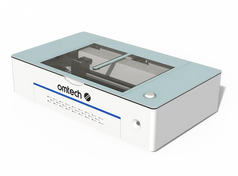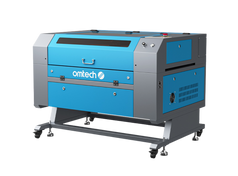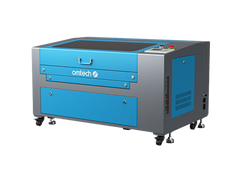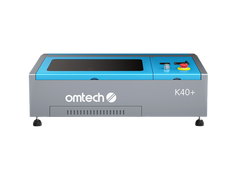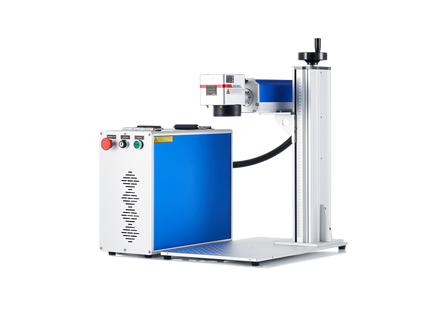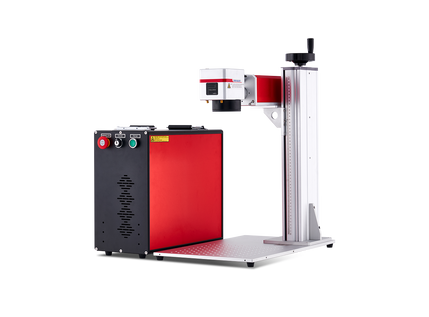How to Set Up a Laser Cutter Exhaust System
Are you ready to safeguard your health and ensure the optimal functioning of your laser engraving machine? The installation of a laser exhaust system is paramount in preventing potentially harmful particles from infiltrating the air you breathe and in eliminating debris that accumulates within the machine. In the absence of a functional exhaust system, the air quality in your workspace will deteriorate rapidly, leading to the accumulation of odors and potential exacerbation of health issues.
Depending on the materials being processed, the odors and toxic fumes produced by laser cutting can pose serious health risks, including respiratory ailments, suffocation, or even fatality. While OMTech laser machines are user-friendly and suitable for home use, it is crucial to remember that these are industrial-grade lasers with inherent hazards, necessitating a steadfast commitment to safety at all times.
The ideal laser engraving exhaust system efficiently expels smoke and odors outdoors, operates quietly, and poses no risk to neighbors or occupants of upper floors. A well-designed laser cutter ventilation system is also essential to prevent the accumulation of smoke within the machine, which can soil the mirrors and focal lens, potentially causing optical damage.
In this article, I will provide guidance on setting up your laser exhaust system and offer examples of various setups to help you identify the most suitable configuration. Whether you are operating in a garage, insulated shed, or a room within your residence, a reliable laser exhaust system is indispensable for your DIY laser projects, your well-being, and the longevity of your laser machine.
- Before embarking on the installation of your exhaust system and commencing testing with your new OMTech laser engraver, ensure that your laser workshop is set up and that you have downloaded your manual.
- Review the safety information in the user manual, adhere to the installation instructions, consult the Installation Guide, and follow the guidelines outlined in this article.
- Additionally, comply with all relevant laws and local regulations pertaining to the safe exhaust of specific engraving materials.
Vocabulary Check: Laser Engraver Exhaust Systems
Before delving into the setup of a laser exhaust system, familiarize yourself with the following essential terms related to laser engraving:
- Laser Exhaust System: Responsible for eliminating engraving debris such as gases, smoke, fumes, and airborne particles. It comprises various components, including but not limited to:Exhaust Vent: The physical outlet through which the laser exhaust exits the building or structure.
- Exhaust Port: The physical port on the laser engraving machine from which the exhaust is expelled. Note that 130W & 150W machines feature two exhaust ports.
- Internal Fan(s): Built-in exhaust fan(s) within the laser, situated at the exhaust output port(s), which extract gases and airborne debris from the worktable.
- Inline Fan: An additional exhaust fan for laser cutters, installed close to the exhaust vent for enhanced fume extraction efficiency.
- Exhaust Duct: The tubing connecting the laser machine's exhaust output port to the inline fan or exhaust vent.
- Fume Extractor: An external device that draws in contaminated air, filters out debris, and releases clean air back into the room. Laser cutter fume extractors are indispensable for enclosed workspaces lacking exhaust vents.
Planning Your Laser Exhaust System
If you have already acquired your laser machine, you likely have a designated location for it. However, if you are still deliberating, the following guidelines will assist you in evaluating your options.
Position your laser engraving machine in close proximity to your exhaust vent, preferably minimizing the number of corners or bends in the ducting and reducing the distance between the machine and the vent. This setup facilitates faster expulsion of contaminated air and odors from your workspace, enhancing the efficiency of the internal laser cutter exhaust fan and preventing the dissemination of laser cutter smells.
Consider the location of your laser workspace and ponder the following questions:
Where Is Your Laser Engraving Machine Located?
- Residential neighborhood or industrial setting
- Garage
- Basement
- Dedicated workshop
- Climate-controlled shed
- Bedroom or office space
- Apartment building
- House or condominium
- Can a window be used for laser machine ventilation?
- Is it feasible to open a window, door, or garage when operating the laser engraver?
- Is drilling a hole in the wall a viable option?
- Are neighbors in close proximity to the laser exhaust vent?
- Are there upper-level rooms above the laser cutter exhaust vent?
- Are there air conditioning units or other air intake systems near the exhaust vent that may draw exhaust back into your building or adjacent structures?
Now that you have contemplated these factors, consider the following laser cutter ventilation options tailored to your workshop scenario.
How to Set Up a Laser Engraving Exhaust System
This guide on Laser Engraver Exhaust System Setup complements the instructions provided in section 3.6 of the OMTech Manual. Familiarize yourself with the complete manual before initiating the setup process.
Standard Setup - Exhaust Vent to the Outdoors via a Window or Door
If a window is conveniently located near your laser machine, you can measure the opening and utilize the laser to cut out a hole of appropriate dimensions. Subsequently, fit the tubing securely within the aperture, ensuring a tight seal—particularly crucial in colder climates where insulating panels may be necessary to prevent drafts.
Alternatively, for venting through a window, consider acquiring an adjustable window dryer vent that seamlessly integrates into the window frame, providing a temporary or permanent exhaust outlet. Following the instructions in section 3.6 of the OMTech Manual and referencing the OMTech Installation Guide will guide you through the setup process.

For those with their laser machine situated near a door, simply extending the tubing through the door may suffice in the short term. However, an open door poses potential drawbacks, including the intrusion of wildlife into the workspace and suboptimal conditions in colder weather unless the area is adequately heated.
Kyle’s DIY Laser Cutter Ventilation System
Kyle, an OMTech user and Demo Room Host, opts for a pragmatic solution by directing the exhaust tubing under his garage door. This interim setup allows him to continue working while refining his workspace to accommodate his ideal laser exhaust configuration.

Laser Exhaust Vent to the Outdoors via the Wall
In cases where no window or door is in close proximity to the machine, drilling a hole in the wall to vent the exhaust outside becomes a viable option. This approach is more suitable for homeowners with prior experience in structural modifications.
Consider the following factors before proceeding with wall venting:
- Ensure the area of the wall earmarked for the cutout is free of wiring and plumbing to prevent accidents.
- Employ specialized detection devices to assess the safety of the cutting area.
- Utilize a suitable tool for drilling or cutting the hole in the wall, ensuring precision and safety.
Bill’s DIY Laser Exhaust System
Personal experiences, such as that of Bill, an OMTech User and Demo Room Host, offer valuable insights into individualized laser exhaust setups:
"The laser cutter ventilation system I have right now is a 6-inch duct running out the side of my house with a dryer vent. I use the AC Infinity 6-inch inline fan for laser cutter. It is held to the side of the machine with heavy-duty magnets. If I were to do it again I would move the fan closer to the exhaust point. I just haven’t got around to doing it yet." - Bill, OMTech User and Demo Room Host

Laser Fume Extractors
In instances where outdoor venting is impractical, investing in a laser fume extractor becomes a viable solution. While these extractors represent a more costly option, they are indispensable for individuals operating in confined spaces where traditional exhaust methods are unfeasible.

What Is a Laser Fume Extractors?
A laser fume extractor functions akin to a vacuum cleaner equipped with a laser exhaust filter, effectively removing airborne particles. By drawing in contaminated air, passing it through specialized filters to eliminate debris, and releasing clean air back into the room, these extractors ensure a safe working environment.

When selecting a laser fume extractor, consider the following factors:
- Opt for a size compatible with your laser machine's workbed dimensions.
- Regularly replace cartridges and filters to maintain optimal performance, varying replacement frequency based on usage.
- Check the shelf life of filters to determine the appropriate replacement schedule, ranging from monthly to biannual intervals.
- Exercise caution when considering DIY exhaust filters or fume extractors, as these may introduce respiratory hazards into the workspace.

OMTech offers a range of laser fume extractors tailored to diverse needs. Ensure compatibility with your laser machine, and connect the extractor's hose directly to the designated port on your laser for seamless operation.

Additional Laser Exhaust System Tips
In addition to selecting an appropriate exhaust setup, consider the following tips to enhance the performance and safety of your laser exhaust system:
- Seal all seams and joints in the metal ducting to eliminate air leaks, utilizing a sealing compound or specialized aluminum tape for a durable and flexible seal.
- Ensure adequate air intake to replace the air exiting the room, facilitating proper ventilation. Open the front pass-thru door on your machine and provide additional entry points for fresh air, such as open windows or doors.
- Check for nearby air intake sources around the exhaust exit point, as air conditioning units or fans may inadvertently draw exhaust back into the building or neighboring structures.
- Upgrade to a more powerful inline exhaust fan to enhance airflow and efficiency, particularly in environments with heavy air contaminants.
- Consider employing an air purifier in dusty environments or woodshops to improve air quality.
- Wear a respirator when working with strong materials like acrylic to mitigate odors and protect against potential respiratory irritants.
- Monitor your health closely and seek medical attention if you experience breathing difficulties or allergy symptoms while working with certain materials.
By adhering to these guidelines and implementing suitable exhaust solutions, you can ensure a safe and efficient laser engraving environment. Stay vigilant, prioritize safety, and remain attentive to your surroundings to mitigate risks and optimize your laser cutting experience.


